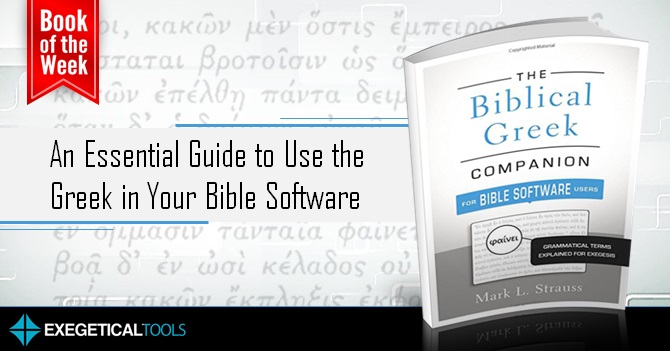Most students and pastors nowadays use some sort of Bible software, whether it’s the big 3 (BibleWorks, Accordance, or Logos) or one of the free programs (e-Sword, BibleSoft, WORDSearch, Blue Letter Bible, or an app). Yet, not all students and pastors have taken Greek or retained it. That means all the capabilities in this software to study the NT in Greek is wasted…until now.
Mark Strauss has created a guide to help you use the Greek capabilities of your Bible software, even if your Greek is rusty or virtually non-existent. Given the significance of Bible software and what it enables us to do, a thin companion such as this is certainly welcomed and useful.
The Biblical Greek Companion for Bible Software Users explains basic grammatical terms that you will see in your Bible software (e.g., when hovering your cursor over a Greek word). The terms are alphabetically arranged for quick reference. When explaining a term, Strauss includes a description of what the grammatical term looks like in Greek, an explanation of how it functions (illustrated by NT examples), and also an exegetical insight that should give the reader an impression of why understanding Greek grammar helps us understand the Bible.
The back contains three appendices: the alphabet, diphthongs & diaeresis, and a third on accents, breathing marks, and punctuation. Including the alphabet was wise because those who have not studied Greek can learn the alphabet, which I would consider necessary before being able to use this companion to understand Greek grammar. The punctuation guide will also help those who have trouble remembering the four marks.
Useful Features
One useful feature is that Strauss includes the Aktionsart categories for verbal tense-forms. For present he includes five (instantaneous, iterative, gnomic, conative, and historical), three for perfect, three for future, three for aorist, four for imperative, etc. All Greek students might appreciate avoiding flipping through Wallace’s Greek Grammar Beyond the Basics to find the categories (and to sort through them all).
Second, the exegetical insights are crucial for a work like this. In the imperative entry, he notes that while we think of imperative verbs as forceful or authoritative commands, they can actually be encouraging, as when Jesus tells his disciples “do not be afraid, you are worth more than many sparrows” (Matt 10:31). Software users might also confuse future indicatives that have imperatival force as being weaker than imperatives, but Strauss suggests that opposite might be true. These sorts of tips are useful for those who are using Greek in their software but do not recall much about how syntax works.
Third, this book is slim–only 112 pages–and each entry spans only two pages. It is ideal to keep nearby your computer for quick reference when preparing sermons or studying Scripture for any reason.
Audience
Those who know their grammar well will not need this companion. It is designed for those who have had some Greek but don’t remember what the accusative does, what particles do, how the imperfect can function, and so forth. As this type of person uses their Bible software to look at the Greek text, The Biblical Greek Companion for Software Users will enable them to understand what the grammar is and how it is functioning (or at least the options for how it could be functioning).
Students who are just beginning Greek, or those who are just starting to regain their Greek, would benefit from this companion. I highly recommend it for its utility and uniqueness.
Preview or buy it here on Amazon.
PS – Check out the Hebrew companion volume as well!


